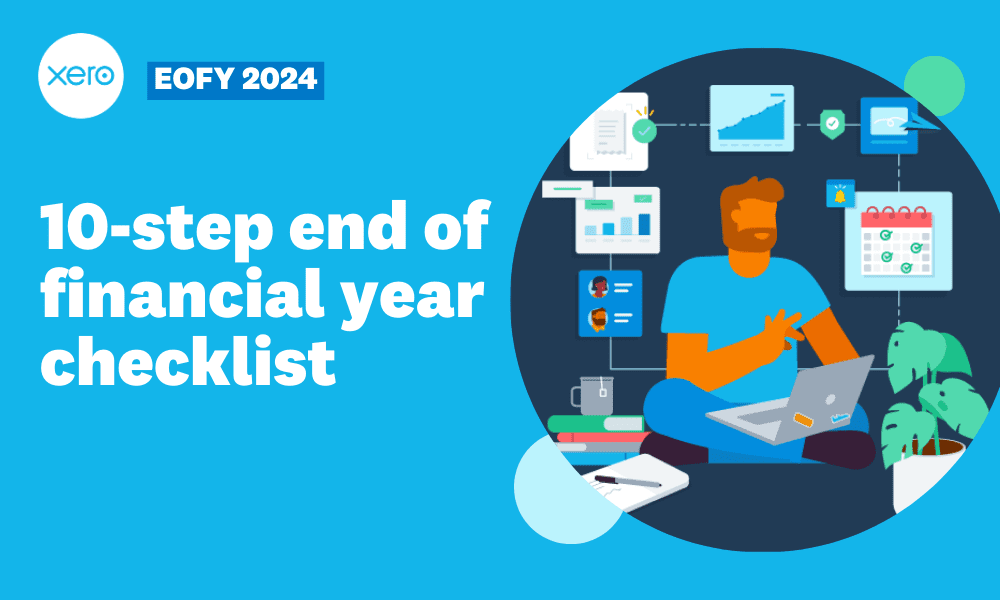
Your 10-step checklist for end of financial year in 2024

We know end of financial year is a busy time, so we’ve prepared a quick 10-step checklist to help you cover your bases at the end of FY24 and start the new financial year off strong.
If you’re using Xero, you can find more helpful information in our handy guide for getting ready for financial year end.
End of financial year checklist for business owners
In no particular order, here are some tasks to tick off to set yourself (and your business) up for a successful FY25.
1. Get on top of your outstanding payments & invoices
Got any outstanding bills to pay, or money to receive? Get up to date on your income by chasing any invoices from customers who haven’t paid yet, and square up anything you still owe.
Save time on sending invoices and reminders in the new year by using an accounting software that does it for you. If you’re using Xero, there’s apps in the Xero App Store that can help with this too.
2. Evaluate your business expenses
You may be able to claim business expenses in your tax return to reduce the total tax you need to pay.
Go over your business expenses to understand where money was spent and identify where you can potentially claim expenses against your taxable income. There are digital tools available that automate your expense management so that it’s less of a headache by the end of the year.
You can also find opportunities to reduce costs, plan your upcoming expenses and make sure you stay profitable in the new financial year.
3. Get up to date with GST
If your business is GST-registered, you’ll need to sum up and pay any GST you owe at the balance date for the end of the financial year. You can do this online, with accounting software or through your myIR account with Inland Revenue. You may want to consult an accountant or bookkeeper for this step.
See our GST guide for business to make sure your bases are covered for filing and paying GST.
4. Take advantage of credits
Depending on your business, you could be eligible for credits that can lower your tax bill. You may want to seek advice on what you could be eligible for.
For example, if your business invested $50,000 or more in certain research and development activities, you could be eligible for a 15% R&D tax credit. Or, if some of your income has come from overseas, you could receive a credit for any foreign tax paid abroad.
5. Review your inventory or services
As part of your year-end review, consider your physical inventory and/or services. This helps confirm what you still have on hand, and that your assets are accurately recorded.
Plus, you can plan for a more profitable FY25 by focusing on what’s selling by:
- Reviewing what was in high-demand in FY24, and what was the most profitable
- Setting a budget for ordering in more products, or promoting the most profitable services
- Retire goods or services that haven’t served the business well – you could offer discounts on discontinued goods, or use them for future promotions
- Consider any new goods and services to offer, based on customer enquiries and what’s already selling well
6. Take a good look at your financial records
Take stock of your payroll, profit and loss statements, balance sheets, and cash flow records at the balance date. This helps you to understand how much profit you might’ve made, view your overall performance for the financial year, and get ready to file tax returns.
Check and fill any missing records or gaps in financial information before closing off your books.
7. Assemble your tax documents
To file your end of fiscal year tax return, you’ll need to finalise payroll and gather your income statements and business expense records.
With this information, you’ll declare the profit your business earned and any expenses you can claim as a deduction to Inland Revenue. You might want to consult an accountant or bookkeeper for this step.
8. Check in with your people
It’s a great idea to connect with staff, customers, and business partners. Ask for feedback on what’s working, what people would like to see more of, and any processes or operational kinks that need smoothing out.
You could do this through surveys and meetings with staff and stakeholders. Be sure to share how you’ve incorporated their feedback.
9. Set yourself some goals for the new financial year
Now that you’ve reflected on the year that’s been, it’s time to set objectives for the year ahead.
Consider your business’s accomplishments and how you could build on those. Set clear, realistic goals for growth opportunities you’ve identified, and identify solutions for challenges the business faced this year.
10. Give yourself time to breathe
Finally, take time to look after yourself. The end of the financial year brings a surge in work to-dos, and it’s important to move into FY25 with strength. Caring for your wellbeing ensures you’re at your best to care for the business.
Take the pressure off with Xero
Feeling the end of financial year stress? Xero’s accounting software can help take the pressure off by automating unloved and tricky tasks, and make it easier to manage your finances throughout the year.
You can even collaborate with your accountant or bookkeeper through the tool, so they stay informed on your business and are in the best position to help.
There’s also a range of apps that connect to Xero, covering everything from debtor management to reporting, payroll and payments in the Xero App Store.
Share this article
[addtoany]

